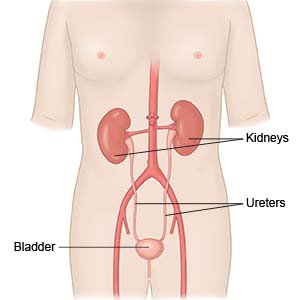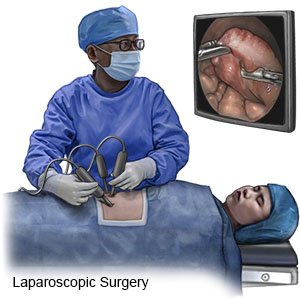Laparoscopic Cystectomy with Ileal Conduit
Medically reviewed by Drugs.com. Last updated on Apr 6, 2025.
What is a laparoscopic cystectomy with ileal conduit?
Laparoscopic cystectomy with ileal conduit is surgery to remove your bladder. Your surgeon will use a scope inserted through small incisions on your abdomen to do the surgery. He or she will use a small section of your intestines to create a urostomy (ileal conduit). This will allow urine to drain from your kidneys through an opening on your abdomen and out of your body. The opening, called a stoma, will be connected to a bag that collects urine.
 |
How do I prepare for surgery?
- Your surgeon will tell you how to prepare. He or she may tell you not to eat or drink anything after midnight on the day of your surgery. Arrange to have someone drive you home after surgery.
- Tell your surgeon about all medicines you currently take. He or she will tell you if you need to stop any medicine for surgery, and when to stop. He or she will tell you which medicines to take or not take on the day of surgery.
- You may be given medicines to prevent blood clots or an infection caused by bacteria.
- Tell your surgeon about all your allergies, including medicines, anesthesia, or antibiotics.
- You may meet with a urostomy specialist to decide the best spot for the opening on your abdomen. You will also learn how to care for your stoma and empty the urine bag.
- You may need blood or urine tests. You may also need an ECG, or x-rays or a CT scan of your kidneys, bladder, or ureters.
Drugs used to treat this and similar conditions
Omvoh
Omvoh is used to treat moderate to severe ulcerative colitis or Crohn's disease in adults. This ...
What will happen during surgery?
- General anesthesia will be given to keep you asleep and free from pain during surgery. Your surgeon will insert a scope through small incisions in your abdomen. He or she will insert tools through the scope to perform your surgery.

- Your surgeon will remove your bladder and may remove nearby tissue or organs. In men, the organs include the prostate and seminal vesicles (glands near the prostate). In women, the organs include the uterus, cervix, ovaries, and fallopian tubes. Your surgeon may also remove part of the urethra and lymph nodes near your bladder.
- Your surgeon will then remove part of your intestine. He or she will use this to connect your ureters to an opening in your abdomen (the stoma). Two small stents (tubes) will be placed inside the ureters to help urine drain while you heal. Your surgeon will close your incision with stitches or staples.
What should I expect after surgery?
You will be taken to a room to rest until you are fully awake. You will be monitored closely for any problems. Do not get out of bed until your healthcare provider says it is okay. You will then be able to go home or be taken to your hospital room.
- You will be helped to walk around after surgery. Movement will help prevent blood clots. You may also be given exercises to do in bed. Do not get out of bed on your own until your healthcare provider says you can. Talk to a healthcare provider before you get up the first time. He or she may need to help you stand up safely. When you are able to get up on your own, sit or lie down right away if you feel weak or dizzy. Then let healthcare providers know you need help.
- Medicine may be given to manage pain. Medicines may also be given to treat or prevent an infection caused by bacteria, or to prevent nausea and vomiting. You may also be given medicine to decrease stomach acid or to make it easier to have a bowel movement.
What are the risks of surgery?
Surgery may increase your risk for bleeding or infection. The stoma may become swollen or painful. Part of your intestine may bulge into the area around the stoma. Urine may leak where the ureters are connected to the section of intestine. You may get a kidney stone. Your ureters may become blocked and not empty urine. Your intestines may also stop working, and it may become difficult to have a bowel movement. You may develop a blood clot in your leg or arm. Any of these conditions may become life-threatening.
Care Agreement
You have the right to help plan your care. Learn about your health condition and how it may be treated. Discuss treatment options with your healthcare providers to decide what care you want to receive. You always have the right to refuse treatment. The above information is an educational aid only. It is not intended as medical advice for individual conditions or treatments. Talk to your doctor, nurse or pharmacist before following any medical regimen to see if it is safe and effective for you.© Copyright Merative 2025 Information is for End User's use only and may not be sold, redistributed or otherwise used for commercial purposes.
Further information
Always consult your healthcare provider to ensure the information displayed on this page applies to your personal circumstances.
